November 27, 2025 | 19:20 GMT +7
November 27, 2025 | 19:20 GMT +7
Hotline: 0913.378.918
November 27, 2025 | 19:20 GMT +7
Hotline: 0913.378.918
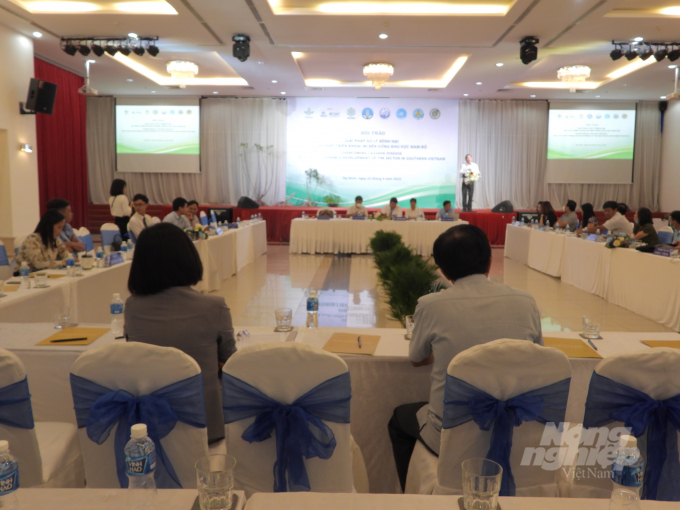
A workshop on solutions to disease treatment and sustainable development of cassava is co-organised by the Tay Ninh Province People’s Committee and CIAT on April 22. Photo: Tran Trung.
According to the Department of Agriculture and Rural Development of Tay Ninh province, the province currently has the second-largest cassava growing area in Vietnam after Gia Lai but the highest cassava yield in the country. The province’s cassava growing area is now about 59,000 ha, accounting for 22.1 per cent of its total agricultural production area.
As of March 18, 2022, the total cassava production area is 46,613 ha. The area infected with leaf mosaic disease is 36,968 ha, accounting for 79.3 per cent of the cassava area of the province.
This year, Tay Ninh province has implemented an intensive cultivation model of cassava, with a total area of 6 hectares, using HN3 and HN5 resistant varieties, implemented in Chau Thanh, Tan Chau, and Duong Minh Chau districts.
The province co-operated with Hung Loc Agricultural Research Centre to test seven new varieties of cassava resistant to leaf mosaic disease. Until now, cassava is nearly 4 months old, in the development stage of tubers. The province coordinated with the Institute of Genetics to assess the adaptability of cassava varieties HN1 and implemented rapid propagation of cassava varieties HN3 and HN5 by propagation method in greenhouses to replace severely ill cassava varieties.
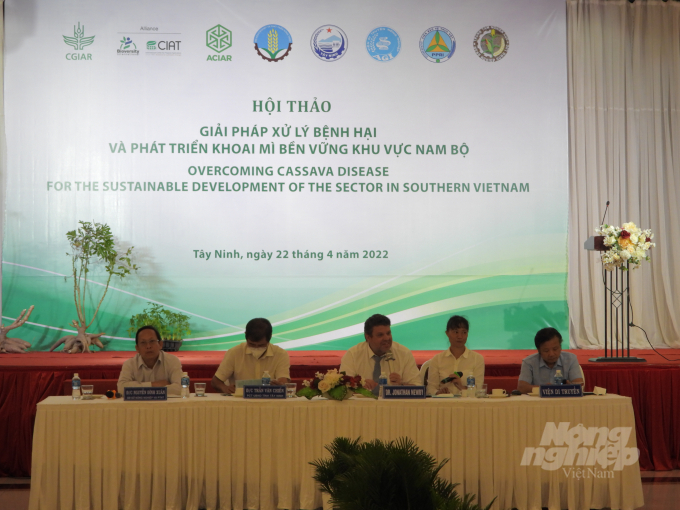
Representatives of Tay Ninh province and CIAT co-chaired the workshop. Photo: Tran Trung.
Nguyen Dinh Xuan - Director of the Department of Agriculture and Rural Development of Tay Ninh province said that Tay Ninh farmers have adapted very quickly since the cassava mosaic disease appeared and broke out.
As soon as cassava mosaic disease appeared in 2017, Tay Ninh authorities and farmers agreed to drastically implement the "zero diseases" policy. However, cassava leaf mosaic is a new, dangerous, and rapidly spreading disease. Tay Ninh province has found a solution to cope with the epidemic.
“ We deployed solutions synchronously to respond to the disease and search for disease-free cassava varieties,” he said.
“Besides the two varieties that have been recognised by the Ministry of Agriculture and Rural Development - HN3 and HN5, four more varieties are about to be recognized. Among them, the HN1 variety is very promising as it can achieve a tuber yield of up to 50 tonnes per ha with a high content of starch," said Xuan.
Xuan added that these cassava varieties still needed further studies on other indicators. For example, in addition to resistance to cassava leaf mosaic disease, these varieties are also resistant to other diseases such as dragon broom disease, stem pus disease, and root rot disease.
“Once the results are very good, agricultural authorities will introduce them to people, not only in Tay Ninh but also the whole country,” he said.
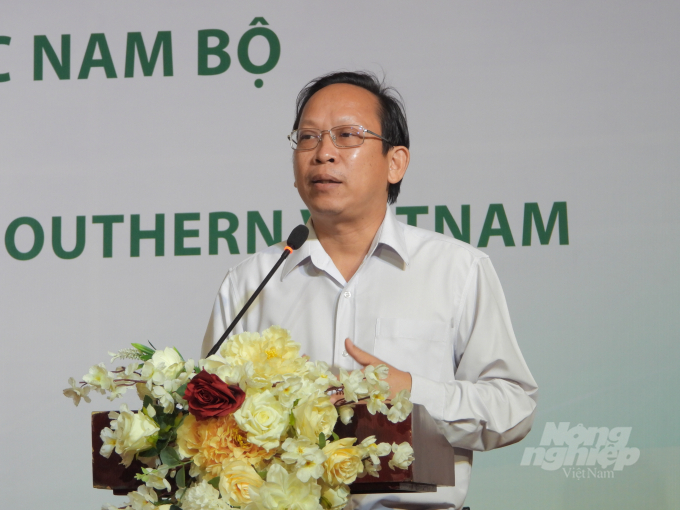
Nguyen Dinh Xuan, Director of Tay Ninh Department of Agriculture and Rural Development shared this at the workshop. Photo: Tran Trung.
Speaking at the workshop, Nguyen Hoan - Chairman of the VAC Association of Tay Ninh province said that leaf mosaic disease was caused by powdery mildew virus, sp besides research on the hybridisation of mosaic resistant varieties, it was necessary to have effective disease prevention measures.
A representative of the Plant Protection Department of the Ministry of Agriculture and Rural Development said that, up to now, people had not been able to control the mosaic epidemic but just identified some problems including backward farming, and improper attention to disease prevention measures. Moreover, seed trading has not been strictly controlled, resulting in substandard seeds being sold widely.
Few mosaic-resistant varieties have been found so research units need to transfer to reputable and capable enterprises for rapid propagation. Local authorities should help raise awareness for farmers while the department will strengthen domestic quarantine and join hands with farmers on safe farming techniques to step by step repel the disease.
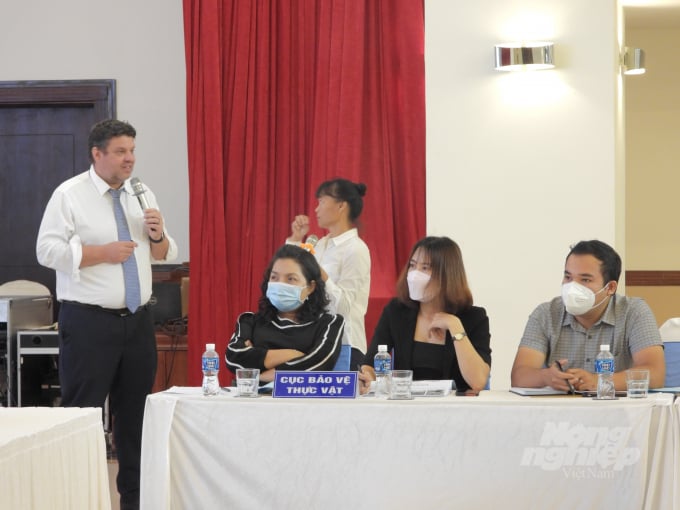
Delegates shared solutions at the workshop. Photo: Tran Trung.
According to Prof. Dr. Le Huy Ham - Director of the Institute of Agricultural Genetics, creating a new variety usually takes 7-10 years. However, it only took us three years to find new varieties that reached record speeds.
“In the joint effort, the direction of international cooperation in production, research on cassava breeding has made an important contribution to the creation of disease-resistant varieties today.
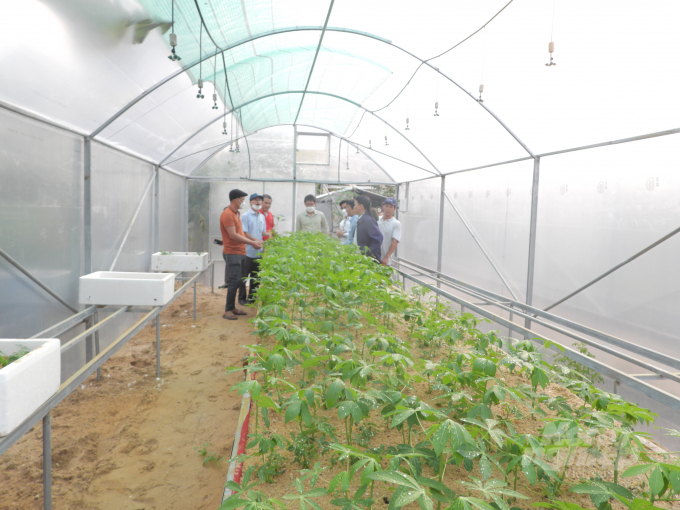
Propagation model by membrane house method in Tay Ninh. Photo: Tran Trung.
Tran Van Chien, Vice Chairman of Tay Ninh Provincial People's Committee said that cassava was a traditional crop that brings high economic efficiency compared to many other crops in the locality. The emergence of cassava leaf mosaic has severely affected the cassava industry in the country.
“Creating a breakthrough in productivity, output, and sustainable benefits for cassava in the future is an urgent issue,” he said.
“This workshop is a meaningful activity to evaluate the genome of cassava varieties resistant to leaf mosaic disease; develop research activities to respond to more dangerous diseases in the future and then, propose solutions for sustainable development of cassava for the Southern region", Chien said.
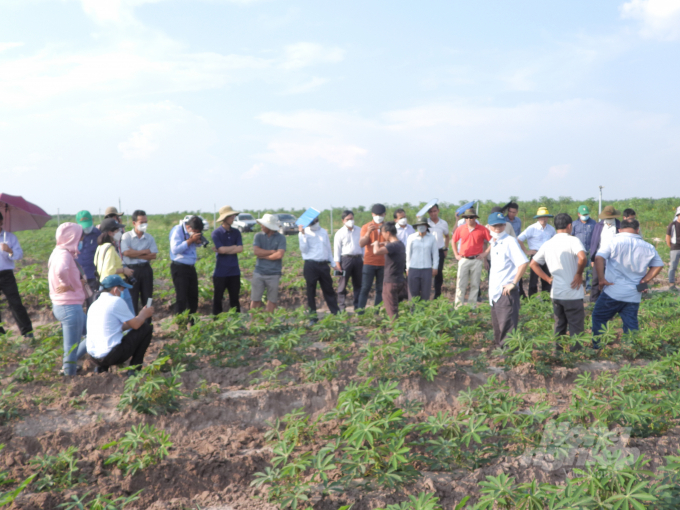
Delegates visited a model of cultivation of mosaic resistant varieties in the Tan Chau district. Photo: Tran Trung.
Previously, the People's Committee of Tay Ninh province in collaboration with the International Centre for Tropical Agriculture (CIAT) organised a visit to the successful new mosaic resistant cassava varieties and the propagation model by the greenhouse method in Tan Chau district.
According to CIAT, this activity is aimed at evaluating the genome of cassava varieties resistant to leaf mosaic disease, creating a basis to continue building research activities to respond to more dangerous diseases on cassava plants that may occur. It also introduced rapid propagation technology and proposed solutions for sustainable cassava development for the Southern region.
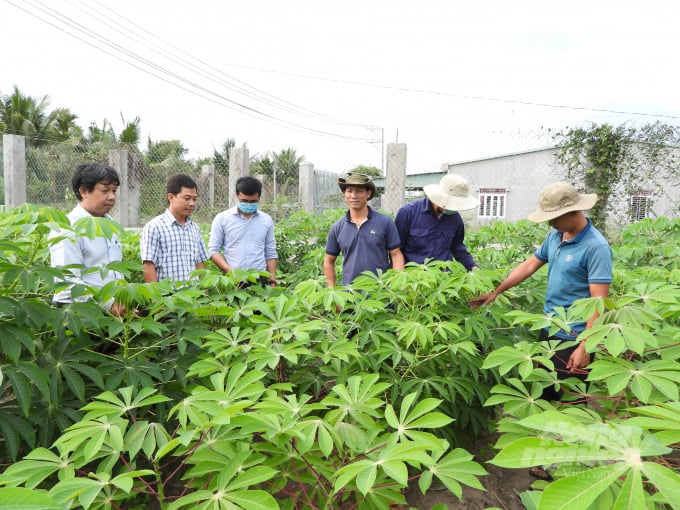
HN5 mosaic leaves- resistant variety is grown in Tan Chau district, Tay Ninh. Photo: Tran Trung.
Activities within the framework of the project to establish solutions to treat cassava diseases in Southeast Asian countries, funded by the Australian Center for International Agricultural Research (ACIAR) in the period 2019-2023.
Translated by Hien Anh

(VAN) According to Mr. Vo Minh Thanh, Director of the Tay Ninh Department of Agriculture and Environment, Resolution 57 has created a new development pathway for the locality, shifting from traditional toward modern agriculture.
/2025/11/26/4909-2-154329_878.jpg)
(VAN) Pearl grouper farming in HDPE cages not only delivers economic efficiency but also contributes to protecting the environment, creating jobs, and promoting marine-based experiential tourism.

(VAN) The model of making a living under the forest canopy through the agroforestry system in Van Son commune, Bac Ninh province, is expected to generate an annual income of approximately VND 30 million/ha.

(VAN) Many enterprises in Can Tho are harnessing natural energy and reducing greenhouse gas emissions in their production processes, thereby contributing to the promotion of a sustainable green transition.
/2025/11/24/3536-2-112800_176.jpg)
(VAN) Dong Nai now has tens of thousands of hectares of forests certified for sustainable management, and this area will continue to be expanded in the coming period.

(VAN) Vinh Ha hamlet (Dai Xuyen commune, Hanoi) is shifting away from small-scale farming as households adopt bioscurity into their breeder chicken models.

(VAN) Heavy rains make aquatic species more vulnerable to disease. Proactive water management and high-tech systems help farmers prevent outbreaks and protect yields.